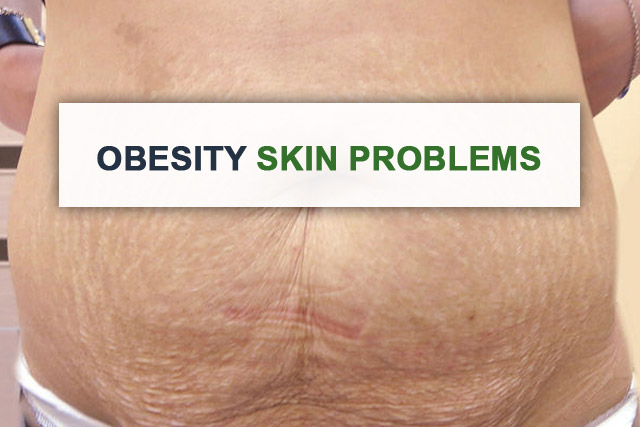Obesity Skin Problems
Obesity Skin Problems – Scientists say that 60% to 70% of people with obesity experience one or several skin conditions. This significantly influences the quality of life of such patients, bringing pain, discomfort, unpleasant smell, and visual changes in their skin health. While, in many cases, skin diseases are benign, in some patients, they grow into malignancies.
Let’s take an in-depth look into the causes of obesity skin problems, find out more about the most common of them, and explain the options you can deal with the diseases.
Am I Obese?
Where comes the red line between being slightly overweight and obese? Medical specialists say that people whose body mass index (BMI) is more than 25 but less than 30 are overweight. Any number exceeding 30 is considered obesity. Still, even at this point, there is a subdivision into obesity and morbid obesity. The latter is diagnosed when your BMI reaches or exceeds 40.
Why is this important? The thing is that significant excessive body mass increases the risk of developing severe skin conditions. The correlation between weight and diseases of the skin is proven scientifically and should be taken into account when evaluating your personal risks.
Why Obesity-Related Skin Diseases Are Common?
Skin is the largest organ in our body. Due to the weight gain, its normal function may be violated, thus triggering the development of various health problems.
- The upper layer of skin, the epidermis, creates a natural barrier that protects our body from external negative influence and prevents our body from the loss of excessive fluid. Obesity alters its function, leading to a higher transepidermal water loss.
- A thick layer of adipose tissue under the skin results in the development of skin folds, which cause increased sweating, friction, and violation of the blood flow in the fat and skin cells.
- Sebaceous glands start working more intensively, thus producing an excess of sebum.
- The flow of lymph in the tissues is impaired. This causes the lymph to concentrate in one area leading to the development of lymphedema.
- The skin on your feet suffers a lot because of the huge pressure created by excessive body mass. This may cause a deformation of the feet and skin problems.
- The production of collagen in the skin of obese people is significantly reduced. This is one of the reasons they have problems with healing wounds.
The Most Common Skin Health Conditions in Obese People
The skin condition influences not only your physical health causing significant discomfort but can also trigger mental health issues due to the visible cosmetic defects appearing. Below you’ll find some common skin diseases affecting most obese patients.
Acanthosis Nigricans
Obesity is one of the risk factors for developing acanthosis nigricans. Based on the results of a study conducted in one of the Texas obesity clinics, 74% of people with obesity suffer some form of this disease. More importantly, the incidence of the disease grows along with the BMI increase. 100% of people whose weight exceeds the norm by 250% or more have this skin condition.
The development of this disease is believed to be provoked by insulin resistance, which is common in people with significant excessive weight.
The characteristic features of the disease include:
- thickening of the skin;
- hyperpigmentation (your skin gets darker in the affected area);
- the plaques are symmetrical;
- thevelvet-like appearance of the affected skin.
The areas where acanthosis nigricans can be observed most often are the back of your neck, groin, and armpits.
Skin Tags
The skin tag is another skin defect that is typical of people with obesity. The incidence of this disease is strongly associated with the patient’s body mass. A 2017 study showed that 66% of obese individuals have this skin condition, while those overweight and with healthy body mass have it 58% and 48.3%, respectively.
Skin tags are usually numerous on the skin. They look like papules hanging off the skin. Tags can be light brown or have the color of your skin. They feel soft to the touch and usually posses zero danger to your health. However, due to their location on the neck, in the armpits, eyelids, groin, and other skin folds, they can bring significant physical discomfort and become a bothering cosmetic defect. What’s more, they don’t disappear after the weight loss.
Stretch Marks
Another skin condition affecting people with rapidly increasing body mass is stretch marks. They are flat lines that look like a tear. However, stretch marks affect only the upper layers of your skin and, therefore, they don’t lead to the appearance of wounds.
In appearance, the striae distensae, as they are also called, are red or purple color. But over time, they will change the color and gradually become lighter than your healthy skin. The areas affected by stretch marks most often include breasts, buttocks, abdomen, and thighs.
While they are not seriously dangerous to your health, stretch marks become a cosmetic defect that cannot be removed with any type of conservative treatment.
Plantar Hyperkeratosis
Plantar hyperkeratosis is a skin condition strongly associated with obesity. It appears due to the increased pressure on the feet. How do you know you have plantar hyperkeratosis? This medical condition shows through the skin thickening over the heels and under your big toe. However, this might be only the tip of an iceberg, and bone changes are possible as well.
Studies say that the incidence of the disease is proportionate to the BMI of an overweight patient. Half of all people with extra weight do suffer from this condition.
This skin condition usually has a significant impact on the quality of life of people with obesity. Cracked heels cause a lot of pain, so wearing shoes and even walking becomes painful. Balance impairment is another thing you may feel due to plantar keratosis development.
Obesity Skin Problems – Hidradenitis Suppurativa
This skin condition is more common in people with a high body mass index as they have more risk factors than those with a normal weight. We now speak about high body fat mass and metabolic syndrome. Hidradenitis suppurativa symptoms include the appearance of cyst-like nodules or abscesses in the skin areas with significant and lasting friction.
The disease manifestations may appear in the armpits, between the buttocks, skin folds, in the groin, and almost anywhere on the body where the skin friction and sweat are almost permanent. This condition causes pain. The cysts may start producing pus or liquid with an unpleasant smell, which only adds to the discomfort you already experience.
Ulceration Due to Venous Insufficiency
In fact, ulceration is only one of the numerous skin problems that may appear due to chronic venous insufficiency. Violation of the blood supply in obese people most often affects the lower extremities. The skin on the legs changes its color to blueish or reddish. Swelling and pain in the legs are also common symptoms accompanying this medical condition.
Taking Care about Wounds in Obese Patients
People with obesity should do all possible to avoid the formation of wounds. While healthy individuals won’t have any troubles with the healing process, high BMI is often accompanied by diabetes, the poor blood supply to the skin and fat tissues, as well as reduced collagen production. All these things have a significant impact on healing.
Wound management in obese patients requires some knowledge and skill. Keeping the wound clean is one of the main tasks of any obese person, which is why hygiene is utterly important.
One of the factors affecting the fast healing of wounds is high blood sugar. If a patient is pre-diabetic or diabetic, they should change their eating habits to normalize a healthy supply of nutrients.
Significant difficulties may come if an obese person undergoes the surgery resulting in the creation of an ostomy. Such patients have much higher risks of complications and require special attention from health care professionals. The ostomy wound-manage skills of the ostomy nurse specialist in the post-operational period and the way a patient takes care of their wound later predetermine the absence of any complications and the quality of life of the patient.
Obesity Skin Problems – Final Words
Obesity is a serious problem that affects millions of Americans of all ages. Not only does it interfere with the quality of life of people who are severely overweight, but it also causes numerous health problems with skin diseases being among the most common.
The number of obese people suffering from one or several skin problems reaches two-thirds of their total number. That’s a lot. And what’s worse, the risks of complications for this category of patients are significantly higher than for those with a healthy weight.
The only way you can prevent the problems we’ve talked about is by losing weight, keeping a healthy diet, and being physically active. Everything is in your hands. But if you need help, there are people and organizations willing to help, so you are not alone with your problem.




